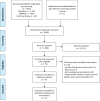Occupational and environmental risk factors of idiopathic pulmonary fibrosis: a systematic review and meta-analyses
- PMID: 33654111
- PMCID: PMC7925580
- DOI: 10.1038/s41598-021-81591-z
Occupational and environmental risk factors of idiopathic pulmonary fibrosis: a systematic review and meta-analyses
Abstract
Idiopathic pulmonary fibrosis (IPF) is a chronic, progressive, fibrosing interstitial lung disease of unknown cause. It has a high risk of rapid progression and mortality. We conducted a systematic review and meta-analysis to evaluate the risk factor of IPF. We searched Medline, Embase, and the Cochrane library from the earliest record to March, 2020. Case-control studies on occupational and environmental risk factors or on jobs with a risk of IPF were searched for. From 2490 relevant records, 12 studies were included. Any occupational or environmental exposure to metal dust (OR 1.83, 95% CI 1.15-2.91, I2 = 54%), wood dust (OR 1.62 5% CI 1.04-2.53, I2 = 5%) and pesticide (OR 2.07, 95% CI 1.24-3.45, I2 = 0%) were associated with an increased risk of IPF. Farming or agricultural work (OR 1.88, 95% CI 1.17-3.04, I2 = 67%) was also associated with an increased risk of IPF. Moreover, smoking increased IPF risk with an odds ratio of 1.39 (95% CI 1.01-1.91, I2 = 29%). In conclusion, metal dust, wood dust, pesticide, occupational history of farming or agriculture and ever smoking increased the risk of IPF.
Conflict of interest statement
The authors declare no competing interests.
Figures




References
-
- Travis WD, et al. An official American Thoracic Society/European Respiratory Society statement: Update of the international multidisciplinary classification of the idiopathic interstitial pneumonias. Am. J. Respir. Crit. Care Med. 2013;188:733–748. doi: 10.1164/rccm.201308-1483ST. - DOI - PMC - PubMed
Publication types
MeSH terms
Substances
LinkOut - more resources
Full Text Sources
Other Literature Sources
Medical

